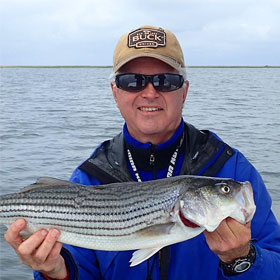How to Fish with Live Shrimp or Minnows Under a Popping Cork
By Ken Schultz
May 21, 2019
For inshore coastal species, how to fish with live shrimp or minnows under a popping cork is about bait and hook size, rig types and uses, technique, and more
Many anglers believe that nothing beats fishing with live bait for coastal inshore species like speckled trout, redfish, and snook. While angling for such fish I primarily use lures, but also have on hand a rod rigged with a popping cork and live shrimp or minnow, which has made the day on many occasions. So here’s some advice on how to fish with live shrimp or minnows with popping corks while plying inshore waters.
Size and Rigging
I’ll take what I can get, but prefer larger bait for larger fish. A number 1 or 1/0 J hook is used by many anglers when fishing with live shrimp and minnows, but I prefer the same size circle hook, which minimizes deep hooking of caught fish and facilitates easy unhooking and unharmed release. One of the absolute tenets of how to fish with live shrimp or minnows using a circle hook is not to make a hard hook-setting motion when a fish takes the bait, but to simply come tight and keep pressure constant.
Live shrimp can be hooked through the top of the head or the tail for free swimming. Minnows (called bull minnows or mud minnows) should only be hooked through the lips; bring the hook point up from the lower lip and then through the upper lip.
I use pre-rigged popping corks which have plastic beads on the upper wire shaft and brass beads on the lower section, the latter producing clicking sounds when the rig is moved. The main body of the cork may be shaped in a cylindrical form, an oval or egg form, or with a tapered body and concave top surface. The latter makes the most commotion, which is especially good in murky or deep water. The other shapes are more subtle, which is good in clear and shallow water.
Tie your main fishing line to the top of the popping cork rig, then tie an 18- to 30-inch fluorocarbon leader (longer for deeper water) from the bottom of the rig to the bait hook eye. Depending on depth and the amount of current or tidal movement, add a small lead split shot to the leader 6 to 8 inches ahead of the hook.


Working (Or Not) the Cork
There are two ways how to fish with live shrimp or minnows under a popping cork: casting and slow-trolling or drifting.
The main purpose of the popping cork is to call a fish’s attention to the bait, primarily through sound. Do this by lowering the rod tip, pointing it toward the cork, then jerking the rod tip down and back to make the cork “pop.” So casting and popping it is the primary action.
Vary the cadence - the times between pops - to see what works, keeping in mind that clear and shallow water may require a less aggressive action. The harder and more frequently you pop, and the more current that exists for a live bait to swim against, the shorter the time that your bait will stay lively. So you may need to change frequently; this is especially true for minnows, which are hardy but of little value when lifeless.
If you’re drifting, or slowly moving your boat via an electric motor or poling, or if you’re fishing from shore with multiple rods, you can fish a minnow under a popping cork without actually popping it (or popping it infrequently). The popping cork just becomes a float (or bobber). You’ll be surprised how often this slow- or no-movement tactic catches fish, provided that the bait is lively and doesn’t get snagged with grass or other debris. A small split shot is usually necessary to keep bait from riding up near the surface, where the fish may not see it but pesky seagulls will.
So get your fishing license, a cork rig, some live shrimp or minnows, and get popping.









